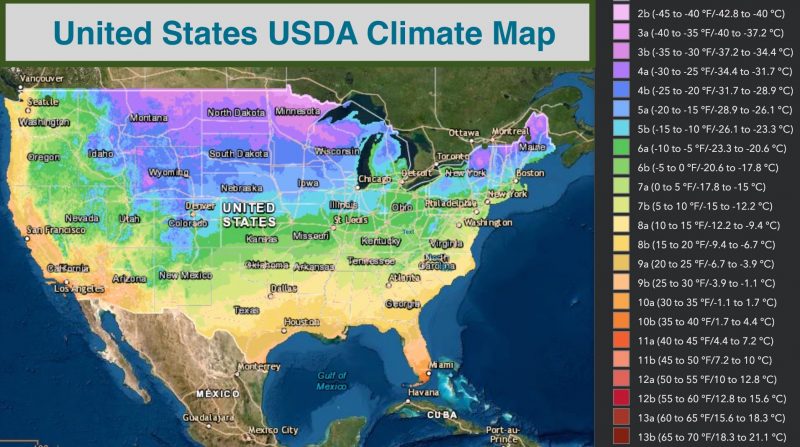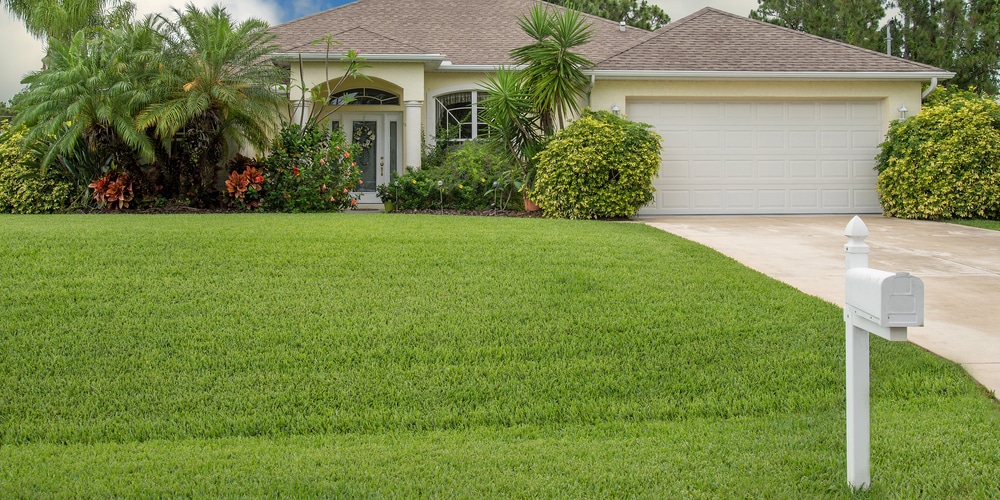Climate Zones & Grass Seed
When selecting grass seed, it’s crucial to know which climate zone your garden falls into.
Climate zones are geographic areas defined by specific weather patterns that significantly impact plant growth, including grass.
Key Factors Defining Climate Zones:
- Average Temperatures: Daytime and nighttime temperatures shape the types of grass that can thrive.
- Precipitation Levels: Rainfall and drought conditions determine water availability for plants.
- Season Length: The duration of growing seasons affects grass maturity and health.
There are generally three primary grass growing zones:
- Cool Season Grass Growing Zone: This zone experiences cold winters and mild summers. Grasses like Kentucky bluegrass and fine fescues flourish here.
- Warm Season Grass Growing Zone: Characterized by hot summers and mild winters, warm-season grasses such as Bermudagrass are well-adapted to these conditions.
- Transition Zone: This zone is a mix, where both cool and warm season grasses can potentially grow, but specific selection is critical for success.
Considerations for Your Garden:
- Identify your zone by referencing a grass zone map.
- Take into account the unique aspects of your garden’s microclimate, such as shade and soil type.
- Remember that zone boundaries are not absolute but provide a general guideline for making the best grass selection.
Types of Grass Seed
When choosing grass seed, it’s essential to pick the right type for your climate. The main categories are cool-season, warm-season, and transitional grasses, each with species optimized for specific weather patterns and growing conditions.
Cool-Season Grasses
Cool-season grasses thrive in northern climates where temperatures tend to be lower. These grasses grow best in the fall and spring and may go dormant during hot summers.
- Kentucky Bluegrass: Ideal for hardy lawns with a lush, fine texture.
- Fine Fescue: Shade-tolerant and perfect for areas with less direct sunlight.
- Tall Fescue: Has deep roots that make it resilient and drought-resistant.
Warm-Season Grasses
In contrast, warm-season grasses are suited for southern regions with hot summers and mild winters. These grasses peak in growth during the summer months.
- Bermuda Grass: Durable and heat-tolerant, it stands up well to heavy foot traffic.
- Zoysia Grass: Requires less watering, making it environmentally friendly.
- St. Augustine Grass: Offers a thick carpet that chokes out common weeds.
Transitional Grass Options
For those living in the middle ground, known as the transition zone, you have unique challenges. This area experiences the extremes of both cool and warm climates.
- Tall Fescue: Often used in transition zones for its versatility.
- Bermuda Grass mixed with Ryegrass: Bermuda provides a green lawn in summer while Ryegrass maintains it during cooler months. More information on this approach can be found in the following guide on choosing the right grass seed.
Evaluating Your Lawn Conditions
Before choosing grass seed, it’s essential to assess the specific conditions of your lawn. This evaluation will inform your selection, ensuring that the grass you plant is compatible with your environment.
Soil Type
To determine the best grass seed, first, analyze your soil type:
- Sandy Soil: Drains quickly but may lack nutrients.
- Clay Soil: Holds moisture well but may have poor drainage.
- Loamy Soil: A balanced mix of sand, silt, and clay, ideal for most grass types.
Sunlight Exposure
Next, evaluate how much sunlight your lawn receives:
- Full Sun: More than six hours of direct sunlight per day.
- Partial Shade: Four to six hours of sunlight, including filtered light.
- Shade: Less than four hours of sunlight per day, or mostly indirect light.
Terrain Features
Consider the terrain’s characteristics:
- Flat Areas: Prone to pooling water and may need aeration.
- Sloped Areas: Prone to erosion; choose grass that establishes strong roots.
Usage
Think about the wear and tear your lawn will face:
- High Traffic: Resilient grass varieties that can withstand heavy use.
- Low Traffic: More delicate grasses that prioritize appearance over durability.
Climate Zone
Different grasses thrive in varying climates:
- Cool Season: Ideal for northern areas with cold winters and mild summers.
- Warm Season: Best for southern regions with hot summers and mild winters.
Grass Seed Planting Techniques
When planting grass seed, your technique can make a significant difference in the establishment and health of your lawn. Here’s a step-by-step guide to ensure optimal growth:
- Prepare the Soil
Begin by clearing the area of debris and weeds. Loosen the top 2 to 3 inches of soil and level it out. Adding a layer of quality topsoil can enhance the nutrient content.
- Choose the Right Seed
Select a grass seed that suits your regional climate as well as your lawn’s sun exposure and foot traffic.
- Sowing the Seed
- Evenly spread the grass seed over the prepared soil, using a broadcaster or by hand for smaller areas.
- For uniform coverage, divide the seed into two halves and spread one half in a north-south pattern and the other in an east-west pattern.
- Maximize Seed-to-Soil Contact
Lightly rake the area to cover seeds with a thin layer of soil. This contact is crucial for germination.
- Moisture is Key
Water the newly sowed area gently but thoroughly. The goal is to keep the top inch of soil moist until the seeds germinate.
Tip: Overwatering can cause the seeds to float away, while underwatering can hinder germination.
- Fertilization
Apply a starter fertilizer to provide essential nutrients that will help your grass seedlings grow strong and healthy.
Maintenance and Care for New Grass
Once you’ve sown new grass seed, proper maintenance is crucial for a healthy lawn. Follow these straightforward steps for the best results:
- Watering:
- Water your new grass seed daily for 15-20 minutes, especially if there’s no rain.
- Maintain a consistent schedule, preferring morning sessions to reduce evaporation.
- Seed Contact:
- Maximize seed-to-soil contact; gently rake the area after seeding.
- Fertilizing:
- Apply a starter fertilizer to provide essential nutrients for the young grass to establish. For specifics, review guidelines on feeding new grass.
- Mowing:
- Wait until your grass reaches 3 inches in height before the first mow to avoid root damage.
- Always use a sharp blade to prevent tearing the tender grass.
- Traffic Management:
- Keep foot traffic to a minimum until the grass is well established.
Frequently Asked Questions
Selecting the right grass seed for your climate zone is crucial for a healthy and resilient lawn. Here are some common questions you might have when choosing the best grass seed for your specific needs.
What factors should be considered when selecting grass seed for different climate zones?
- You should take into account the temperature patterns of your area, the amount of sunlight, and shade available, and local precipitation trends.
- Soil type and its ability to retain or drain water also play significant roles in your decision-making process.
Which grass seed varieties are best for both winter hardiness and summer resilience?
- Kentucky bluegrass and turf-type tall fescue are known for their ability to withstand cold winters and still remain hardy during hot summers.
- These grass types often have deep root systems that make them more drought-tolerant and robust against temperature extremes.
How can you determine the most appropriate grass seed for areas with full sun exposure and potential drought conditions?
- Look for grass seeds labeled as drought-resistant, such as Bermuda grass or Buffalo grass, which are suitable for full sun exposure.
- These grasses typically require less watering and can thrive in areas that receive intense sunlight for the majority of the day.
What attributes make a grass seed ideal for establishing a thick, lush lawn?
- Grass seeds that have high germination rates and disease resistance will help establish a healthy lawn.
- Selecting a seed blend that is tailored for your region’s specific conditions can contribute to a denser and more uniform lawn.
What should one look for in a grass seed to ensure successful growth in a cool climate region?
- In cooler climates, your best options are grass seeds known for cold tolerance, such as rye grass or fine fescues.
- These grass types have the ability to germinate in colder temperatures and can provide a green lawn even during the chillier months.
What are the recommended grass seed types for maintaining a healthy lawn in the transition zone?
- The transition zone is challenging, so grass seeds like Zoysia grass and tall fescue are recommended since they can handle both heat and occasional cold snaps.
- These grasses are versatile enough to adapt to varying temperatures and can recover from environmental stresses more effectively than others.
Last update on 2025-04-18 / Affiliate links / Images from Amazon Product Advertising API




